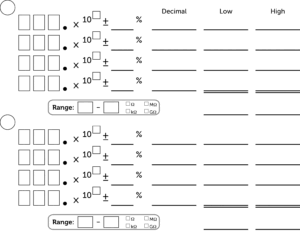We know what percentages are. Now, we will apply percentages to a common application in the trades: tolerance. When you buy a box of nails that says it has 200 in the box, and it actually has 201 or 199 nails, the tolerance is ±1 nail. For resistors, tolerance is expressed as a percentage.
Calculating a resistor’s tolerance is another 3 step process:
- Translate the Band Colors into numbers. Use this link to open a resistor band conversion pdf: resistor_code
- Band Colors. Notice that there are 4, 5 and 6 Band resistors. All of the resistors in the above graphic on this page are 4 Band resistors. The first resistor in the pdf is also a 4 Band. In a 4 Band, only the first two colors are the resistance values in ohms. 5 and 6 Band resistors have three numbers for resistance. So the first resistor in the pdf has a Red and Green, or 25.
- Apply the Multiplier. Now we “move the decimal” just like we did for metric unit conversions. I organize the 3 Steps with a Worksheet The next Band is called the Multiplier. Just like a metric prefix (kilo, milli) can move the decimal left or right, so to can a Resistor Band Multiplier. In our 4 Band resistor, the next color is Orange, which means our Multiplier is +3. So our resistance value is now: 25 × 10+3 ohms. All a positive 3 means is that you are going to move the decimal 3 places to the right, making our resistance value 25,000 ohms.
- Calculate the Tolerance. Now that we know what the resistance is supposed to be, we can apply the Tolerance value to figure out the + and −, like we did for the extra or missing nail. In our example, the last color is Gold. Notice that White, Gold and Silver colors are outlined in black to distinguish them from the other colors. In an actual resistor, you won’t see black outlines. Gold means a tolerance of 5%. Here’s the calculation we have to do: 5% × 25,000 = 1,250 That means the actual resistance value is between 23,750 ohms and 26,250 ohms.
Let’s practice some more … resistor_practice




